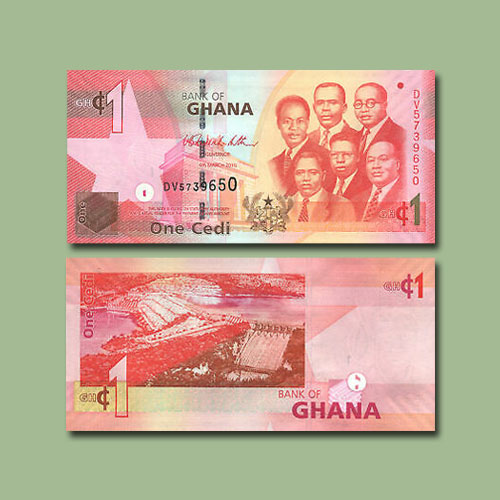Ghana 1 Cedi banknote
2020-01-08 Wed
Ghana, a nation on West Africa’s Gulf of Guinea, is known for diverse wildlife, old forts and secluded beaches, such as at Busua. Coastal towns Elmina and Cape Coast contain posubans (native shrines), colonial buildings and castles-turned-museums that serve as testimonials to the slave trade. North of Cape Coast, vast Kakum National Park has a treetop-canopy walkway over the rainforest.The Ghanaian pound was the currency of Ghana between 1958 and 1965. It was subdivided into 20 shillings, each of 12 pence. Until 1958, Ghana used the British West African pound, after which Ghana introduced the first Cedi.
It is the fourth historical and only current legal tender in the Republic of Ghana. One cedi is divided into one hundred pesewas. The Bank of Ghana has been issuing all Ghanaian banknotes since 1958.
Today we are looking at a 1 Cedi banknote issued from 2007 to 2010. The obverse depicts the Independence Square of Accra, Ghana, inscribed with the words "Freedom and Justice, AD 1957" in centre background. To right are depicted ‘The Big Six’ - six leaders of the United Gold Coast Convention (UGCC), the leading political party in the British colony of the Gold Coast: Dr. Ebenezer Ako-Adjei, Edward Akufo-Addo, Joseph Kwame Kyeretwie Boakye Danquah, Kwame Nkrumah, Emmanuel Odarkwei Obetsebi-Lamptey, William Ofori Atta. The official Coat of Arms is seen centre right bottom.
The reverse depicts the hydroelectric power plant on Lake Volta and Akosombo Dam to left centre and a stockpile of gold bars to right. This Red and Rose coloured note has a portrait of Tetteh Quarshie, a pre-independence Ghanaian agriculturalist; Cacao pod; Electrotype "1"; and Cornerstones as its watermark.
Image Courtesy: PicClick
Latest News
-
Panchala King Bhanumitra Copper Coin
2024-04-26 FriThe Panchala kingdom was ruled by the Mitra kings. The Mitra kings are known to issue coins and most...
-
Mahatma
2024-04-25 ThuIndia Post issued a commemorative postage stamp on #LalaHansraj, also known as Mahatma Hansraj for�...
-
Berar Mint of Muhammad Akbar
2024-04-25 ThuBerar was a kingdom located in the Deccan region, with Elichpur as its capital. It was one of the Su...
-
Janma Kalnayak of Bhagwan Mahavir
2024-04-24 WedOn 21st April 2024 which was the 2550th Janma Kalnyanak of Bhagwan Mahavir Swami, PM Modi unveile...
-
Gold Pagoda of Vijaynagar Empire King Deva Raya I
2024-04-10 WedKing Deva Raya I of the Vijayanagara Empire was a patron of Kannada literature and architecture. He ...

